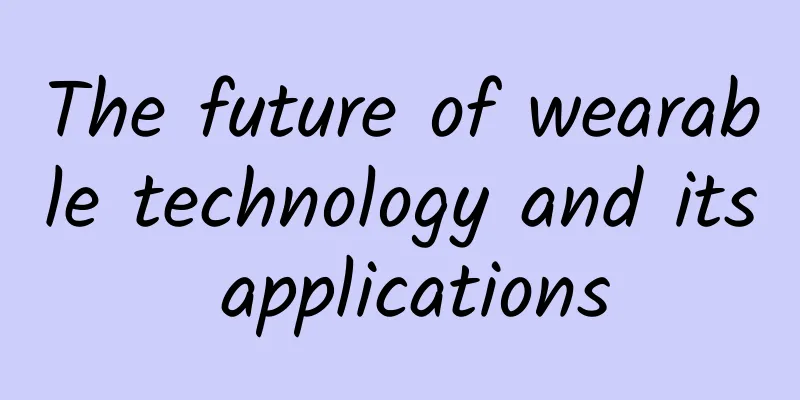The future of wearable technology and its applications

|
Wearable technology has evolved rapidly over the past few years, changing the way we use and think about technology. Wearable devices such as smart watches, fitness trackers, virtual reality (AR) glasses, and smart clothing are more than just tools, they are now an important part of our daily lives. This article will discuss the future of smart technology and look at how it can be applied in different fields. Health and well-beingHealth and wellness is one of the most promising areas for smart technology. Wearable devices can keep a close eye on vital signs, track exercise, and collect useful health data in real time. This information can be used to study people's health, identify problems, and even predict future health problems. In the future, electronic devices will play an important role in online patient tracking. This will help doctors and nurses keep track of the patient's condition and take quick action when needed. In addition, wearable devices can help people get personalized health advice, which can help them live a better life and avoid getting sick. Fitness and SportsWearable technology was initially used for fitness and sports, and it is likely to continue to grow in the future. Some of the best fitness apps can record a person’s heart rate, calories burned, sleep, and more. As sensor technology improves, trackers will become more accurate and provide more biometric data. Wearable devices can measure sports data in real time, track muscle fatigue, and help avoid injuries, which is helpful for athletes. Wearable devices can also provide players and fans with realistic AR/VR experiences, real-time data and teaching tips, thereby improving the overall sports experience. Augmented and virtual realityAugmented reality (AR) and virtual reality (VR) will play a role in the future of personal technology. AR glasses and headsets combine the real and digital worlds by adding digital information on top of the user's view of the real world. Wearable AR devices can improve work efficiency by showing users relevant information, giving step-by-step instructions, and allowing users to participate without using their hands. AR devices can improve efficiency in engineering, manufacturing, and transportation, reduce errors, and make complex tasks easier to complete. VR glasses, on the other hand, take users into a completely simulated world, allowing users to have intense experiences and can be used for entertainment, education, training, and therapy. Fashion and personal expressionFashion and wearable technology are increasingly coming together to create a new world of smart clothing and objects. With built-in sensors, smart fabrics can track body temperature, heart rate and muscle movement, providing information about health and performance. Wearable fashion technology can also enable clothing to change color or pattern, respond to the surrounding environment, or connect to digital devices so that they can communicate and be controlled. In the future, there will be many options for wearable fashion, and technology and style will be more integrated. This will help people show their personality and creativity through new and useful gadgets. Work efficiency and safetyWearables can transform the productivity and safety of workers in a variety of businesses. Smart glasses or head-high displays can provide people with information in areas such as production, transportation, medical information, directions, and real-time data without having to use their hands. Wearable devices can check the surrounding environment, detect hazardous chemicals, and warn employees of possible dangers. In addition, gadgets can make it easier for teams to communicate and collaborate with each other, which can increase speed and reduce errors. As technology advances, electronics will become an important part of the future workplace. This will help people work faster and better. Games and EntertainmentThe gaming and leisure industries are about to change thanks to wearable technology. With haptic feedback, motion tracking, and biometric monitors, gaming devices can provide a realistic experience. Virtual reality glasses and wearing haptic suits or gloves can make the gaming experience real and engaging. Wearables can enhance live events, shows, and theme parks in ways that go beyond gaming. For example, customized experiences, engaging elements, and added content can be provided. The future of entertainment will be driven by gadgets that cross the boundaries between the real and digital worlds, creating experiences that are both fun and memorable. Environmental Monitoring and SustainabilityWearable technology can help with environmental tracking and trying to be more sustainable. Wearable devices with outdoor monitors can measure air quality, temperature, noise levels, and other things. This information can help people and groups make better choices about their surroundings, use less energy, and reduce their impact on the world. Wearables can also encourage people to do things that are good for the environment, such as giving feedback and rewards for using less energy, reusing more energy, or adopting greener habits. Future devices in this area hold a lot of promise for making society healthier and more environmentally conscious. Personalized learning and trainingWearables can go a long way toward making learning and training more personalized. Wearables can change learning materials and training programs in real time by tracking data about how people think and how their bodies work. It can track levels of attention, worry, and interest to make the learning experience better and give specific feedback. Augmented reality images on wearable devices can also help with practical training by providing step-by-step instructions and suggestions for difficult tasks. Wearables can change the way we learn and acquire new skills in school and in the workplace. Mental Health and Well-BeingWearable technology can help track and support people’s mental health. Wearables can provide people with information about their stress levels, emotional health, and general mental health by measuring changes in their heart rate, sleeping patterns, and how active they are. Wearables can alert users to possible signs of worry or sadness and suggest ways to cope with stress or improve sleep. Wearables can also help with awareness activities such as guided meditation, biofeedback, and relaxation methods. Future mental health devices are expected to make it easier to detect, avoid, and treat mental health issues early. Assistive TechnologyWearables can give people with disabilities more control and be used as tools for useful technology. For example, smart glasses that can recognize objects can help people with visual impairments by providing visual or audio cues. Wearables can also help those with limited mobility by providing them with exoskeletons or smart devices to make them more mobile and independent. In addition, translation or recording tools that work in real time can make it easier for people with hearing impairments to communicate. The goal of future useful tools is to break down boundaries and give everyone the same opportunities. Privacy and Data SecurityAs more people wear technology, privacy and data security become increasingly important. Wearable devices collect a lot of personal and private information, such as biometric information, location information, and behavioral trends. It is important to establish strong privacy rules, send data in a secure way, and provide people with clear ways to control how their data is shared. Wearable device manufacturers and service providers must put user privacy first and implement strict security measures to prevent private information from being accessed or leaked by unwanted parties. SummarizeThere are many exciting things that could happen in the future as portable technology advances. Wearable devices will change many different industries and make our daily lives better. They can be used for everything from personalized healthcare to interactive entertainment, from environmental tracking to personalized learning. As technology continues to advance, it is important to consider issues such as privacy, security, ethics, and how to work with other new technologies. Wearable technology will certainly take advantage of these challenges and opportunities to change the future. It will empower people, improve health, and change the way we connect with the world around us. |
<<: The official version of iOS 17.4 is here, summary of new features!
>>: How do iPhone and Android phones receive push notifications?
Recommend
How to place advertisements for novice APP operators
What is operation ? This kind of question appears...
This "smallest organ in the human body" cannot be ignored when injured!
《Cotton Swab Medical Science Popularization》 Xia ...
Mou Cong Bodybuilding Elite Training Camp Lecture Video
Introduction to Mou Cong Bodybuilding Elite Train...
Please, don't put big ears and antlers on your cycling helmets!
Do you need to wear a helmet when riding a motorc...
Aiti Tribe Story Collection (25): Analysis of Chain Storage Stack and Code Implementation
[51CTO.com original article] Xiao Yao graduated f...
The basics of through train promotion, a must-read for newbies!
Today I’m going to share with you some basic thro...
Can people with diabetes eat mooncakes? Be careful about "sugar-free mooncakes" and don't eat them casually
During the Mid-Autumn Festival, it is a Chinese c...
The weather is cold, should we eat food while it is hot? Be careful to increase the risk of cancer!
Review expert: Peng Guoqiu, deputy chief physicia...
The privatization of the brands of Mixue Bingcheng and Yuanqi Forest!
According to the "2020 China Fast Moving Con...
Science Time Machine | The “birth” of batteries can actually be thanked to frogs?
One of the important qualities of scientists is t...
The official version of iOS 14.3 is here. Should I upgrade? Those who are confused should read this.
As long as Apple's IOS system is updated, I u...
AI plays games better than humans? But what's the point of letting AI play games...
Welcome to Science Popularization China’s special...
Flame Encounter! The correct way to find fireball meteorites on the road, will this be possible?
How scientists found a rare fireball meteorite on...
iOS 14 jailbreak tool updated, SEP vulnerability open source downgrade is expected?
The long-awaited checkra1n jailbreak tool has fin...
Year-end review: Interpretation of the top ten domestic technology news in 2021
The year of 2021, with its climaxes one after ano...









